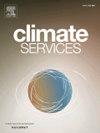Reflections on the large-scale application of a community resilience measurement framework across the globe
IF 4
3区 环境科学与生态学
Q2 ENVIRONMENTAL SCIENCES
引用次数: 0
Abstract
This paper reflects on learnings and analysis from an extensively globally applied, standardized community disaster resilience measurement framework that utilises bottom-up (locally collected) data. These lessons, from over a decade of on-the-ground work and analysis, are based on empirical evidence and have salience for scholars, policy-makers and practitioners aiming to strengthen community disaster resilience and apply bottom-up community disaster resilience measurement approaches. The Flood Resilience Measurement for Communities approach was co-designed and implemented by the Zurich Flood Resilience Alliance: a transdisciplinary science-policy-practice collaboration including scientists, practitioners and private business. It has been applied globally in approximately 400 communities worldwide, demonstrating the real-world impact of scalable community disaster resilience measurement initiatives. Findings provide evidence for the impacts and good practices of applying bottom-up community disaster resilience measurement approaches. Quantitative analysis on this unique dataset provides new entry points for research on typologies and dynamics of resilience, based on empirical evidence on human, social, physical, natural and financial dimensions. Based on our analysis, we find that the use of bottom-up, multidimensional, standardized community disaster resilience measurement approaches is a worthwhile endeavour to support community disaster resilience strengthening.
社区恢复力测量框架在全球范围内大规模应用的思考
本文反思了一个广泛应用于全球的标准化社区抗灾能力测量框架的经验和分析,该框架利用自下而上(当地收集)的数据。这些经验教训来自十多年来的实地工作和分析,基于经验证据,对旨在加强社区抗灾能力和应用自下而上的社区抗灾能力测量方法的学者、政策制定者和实践者具有重要意义。“社区抗洪能力测量”方法由苏黎世抗洪能力联盟共同设计和实施,该联盟是一个跨学科的科学-政策-实践合作组织,包括科学家、从业人员和私营企业。它已在全球约400个社区得到应用,展示了可扩展的社区抗灾能力测量计划对现实世界的影响。研究结果为应用自下而上的社区抗灾能力测量方法的影响和良好实践提供了证据。基于人类、社会、物理、自然和金融方面的经验证据,对这一独特数据集进行定量分析,为研究复原力的类型学和动态提供了新的切入点。根据我们的分析,我们发现使用自下而上、多维度、标准化的社区抗灾能力测量方法是支持社区抗灾能力加强的一项有价值的努力。
本文章由计算机程序翻译,如有差异,请以英文原文为准。
求助全文
约1分钟内获得全文
求助全文
来源期刊

Climate Services
Multiple-
CiteScore
5.30
自引率
15.60%
发文量
62
期刊介绍:
The journal Climate Services publishes research with a focus on science-based and user-specific climate information underpinning climate services, ultimately to assist society to adapt to climate change. Climate Services brings science and practice closer together. The journal addresses both researchers in the field of climate service research, and stakeholders and practitioners interested in or already applying climate services. It serves as a means of communication, dialogue and exchange between researchers and stakeholders. Climate services pioneers novel research areas that directly refer to how climate information can be applied in methodologies and tools for adaptation to climate change. It publishes best practice examples, case studies as well as theories, methods and data analysis with a clear connection to climate services. The focus of the published work is often multi-disciplinary, case-specific, tailored to specific sectors and strongly application-oriented. To offer a suitable outlet for such studies, Climate Services journal introduced a new section in the research article type. The research article contains a classical scientific part as well as a section with easily understandable practical implications for policy makers and practitioners. The journal''s focus is on the use and usability of climate information for adaptation purposes underpinning climate services.
 求助内容:
求助内容: 应助结果提醒方式:
应助结果提醒方式:


